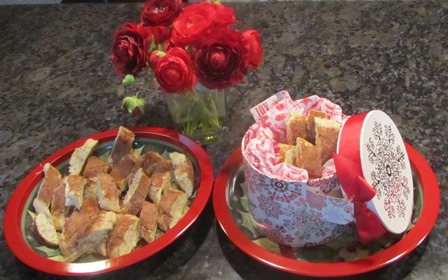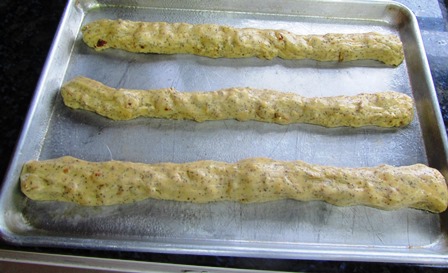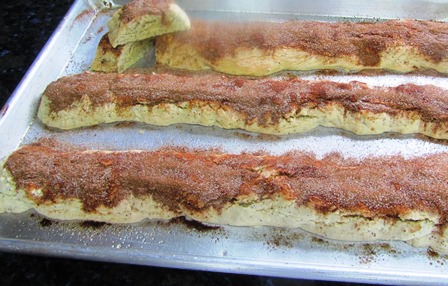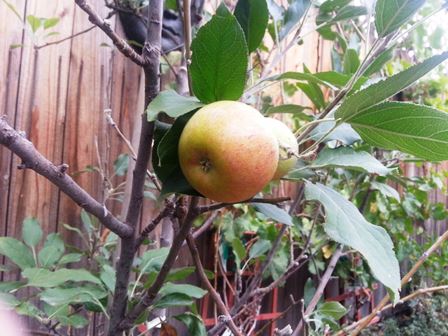Making Holiday Mandelbrot
Before my husband passed away at 46 from complications after a heart transplant, he used to accompany our son and his boy scout troop to Dodge Ridge for an annual ski trip (depending on the snow levels). The mandelbrot (twice-baked biscotti) I packed for them was always a hit, and each year the scouts would request it.
Making this biscotti has become an annual tradition for me at this time of year. I usually make several batches, dividing the dough into equal size balls first and then molding them into logs for baking. Mandelbrot is a Yiddish word, meaning almond bread (“mandel” for almond, “brot” for bread).
The pieces should be stored in an airtight container for gift-giving or for parsing out over the holidays with a hot cup of tea or mulled wine (my favorite mulled wine recipe relies on a ratio of 6-2-1 of claret, cider, and orange juice, plus honey and spices and citrus peel).
Our Family Favorite Mandelbrot
Ingredients:
1 cup sugar
3 eggs
3/4 cup canola oil
1 teaspoon vanilla
1/2 teaspoon almond flavoring
3 cups flour
1 teaspoon baking powder
dash of salt
2 tablespoons poppy seeds
1 cup coarsely chopped almonds (alternatively: pecans or walnuts)
Directions:
Set oven to 350 degrees Fahrenheit
Spray oil over a baking sheet.
Cream together sugar, eggs, oil, vanilla, and almond flavoring in the large bowl of an electric mixer.
Add flour, baking powder, salt, poppy seeds, and nuts and blend well.
Divide the dough into three equal balls.
Roll each ball in your hands to make a long roll, the length of the cookie sheet.
Repeat the process with the remaining two balls.
Place the three rolls at least 2 inches apart on the cookie sheet (they’ll expand and flatten slightly during the baking).
Bake for 20 minutes (the rolls will appear golden brown)
Remove from heat and let cool while you make the topping.
Topping:
Whisk together 2 tablespoons of sugar and 2 tablespoons of cinnamon until thoroughly blended.
Sprinkle the rolls with the cinnamon-sugar topping.
Return the biscotti to the oven for approximately 2 to 3 minutes.
Remove and let cool.
Make 2-inch wide slashes on the diagonal.
Store the biscotti in an airtight container.
For more delicious recipes, farming tips, and a cozy whodunnit, check out my newest novel, available on Amazon, Barnes & Noble, and other online and brick-and-mortar stores.
Celebrating the Season of Apples
It’s that time of year when the scents of cinnamon and apple potpourri mingle with hot mulled cider. Thank you, Johnny Appleseed.
Or should I say, thank you, John Chapman (1174-1845). Born in Leominster, Massachusetts, Chapman planted apple orchards on lands in the northeastern and mid-western parts of the United States, returning after several years to sell those orchards after they were producing.
He also gave away many trees and seeds. But he didn’t believe in grafting, and the trees he planted bore apples more suited to cider. See, http://www.smithsonianmag.com/arts-culture/real-johnny-appleseed-brought-applesand-booze-american-frontier-180953263/?no-ist
It was John Chapman’s father Nathaniel–a farmer–who encouraged his son to become an orchardist. John planted more than a few orchards around the Midwest on lands he bought, owned, and sold. His life gave rise to the folk tradition of Johnny Appleseed. Today, there are many festivals that honor his life and work as well as a U. S. postage stamp.
Today, you don’t need a lot of land to grow an apple tree or two. Even a small piece of land can accommodate the fruit tree, thanks to the availability of dwarf and semi-dwarf varietals. Apartment dwellers and people who have limited space can even espalier an apple tree against a wall.
On the Henny Penny Farmette, we are growing the thin-skinned Cox Orange Pippin dessert apple, among others. This late-season varietal was first grown in 1825 in Colnbrook in Buckinghamshire, England. The flesh is orangey-red and the flavor is sweet and nutty. These apples can be eaten fresh, used in recipes, or made into cider.
If you have some cider on hand and would like to create the mulled apple cider flavor, add a couple of cinnamon sticks, a teaspoon each of whole cloves and allspice with a half-gallon of cider and heat in a saucepan. Add a little orange juice or some slices of orange. After simmering for 8 to 10 minutes, strain the mulled cider into mugs. Consider making a batch of farmhouse doughnuts to accompany the cider.
FARMHOUSE DOUGHNUTS
Ingredients:
1 pkg. yeast
1 cup lukewarm milk
1/2 teaspoon salt
31/2 cups flour
1/4 cup canola oil, plus oil for frying
1 cup brown sugar
2 eggs, well beaten
3/4 teaspoon nutmeg
Directions:
Mix together the yeast and milk in a small bowl.
Combine flour with salt in a large bowl.
Add the yeast and milk to the flour and salt mixture and beat well.
Let the mixture rise for one-half hour.
Add all the other ingredients and beat well again.
Let rise for one hour.
Punch down the dough. If it appears too soft to roll out, add more flour.
Turn the dough out onto a well-floured board and let the dough rest for ten minutes.
Divide the dough in half. Roll one section of dough out to 1/2 inch thickness and cut with a doughnut cutter. Repeat the process for the other half of the dough.
Let the doughnuts rise for about an hour; fry in oil at 360 degrees Fahrenheit. When the doughnut has turned brown, flip over. Take care not to burn.
Remove from doughnuts from hot oil and drain on paper towels.
Place doughnuts in a bag with granulated sugar and shake to coat. Makes approximately two dozen doughnuts and holes.
 Facebook
Facebook Goodreads
Goodreads LinkedIn
LinkedIn Meera Lester
Meera Lester Twitter
Twitter







